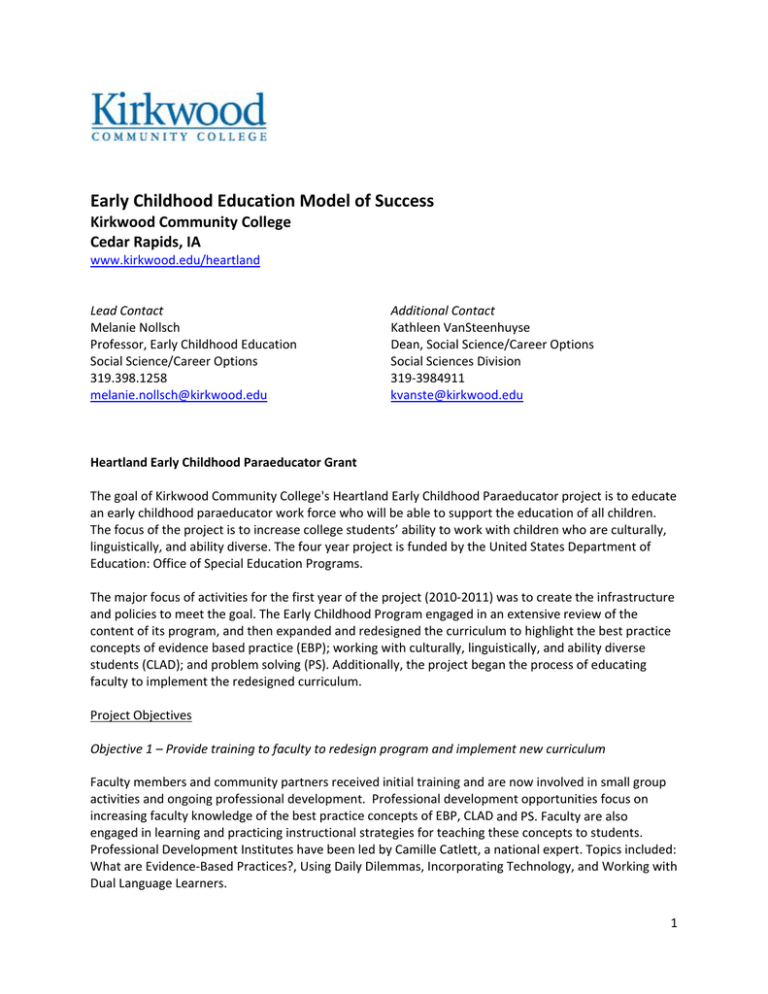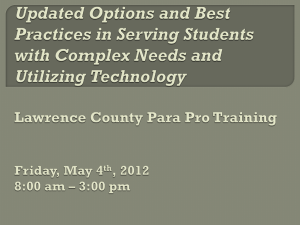Heartland Early Childhood Paraeducator Grant
advertisement

Early Childhood Education Model of Success Kirkwood Community College Cedar Rapids, IA www.kirkwood.edu/heartland Lead Contact Additional Contact Melanie Nollsch Kathleen VanSteenhuyse Professor, Early Childhood Education Dean, Social Science/Career Options Social Science/Career Options Social Sciences Division 319.398.1258 319‐3984911 melanie.nollsch@kirkwood.edu kvanste@kirkwood.edu Heartland Early Childhood Paraeducator Grant The goal of Kirkwood Community College's Heartland Early Childhood Paraeducator project is to educate an early childhood paraeducator work force who will be able to support the education of all children. The focus of the project is to increase college students’ ability to work with children who are culturally, linguistically, and ability diverse. The four year project is funded by the United States Department of Education: Office of Special Education Programs. The major focus of activities for the first year of the project (2010‐2011) was to create the infrastructure and policies to meet the goal. The Early Childhood Program engaged in an extensive review of the content of its program, and then expanded and redesigned the curriculum to highlight the best practice concepts of evidence based practice (EBP); working with culturally, linguistically, and ability diverse students (CLAD); and problem solving (PS). Additionally, the project began the process of educating faculty to implement the redesigned curriculum. Project Objectives Objective 1 – Provide training to faculty to redesign program and implement new curriculum Faculty members and community partners received initial training and are now involved in small group activities and ongoing professional development. Professional development opportunities focus on increasing faculty knowledge of the best practice concepts of EBP, CLAD and PS. Faculty are also engaged in learning and practicing instructional strategies for teaching these concepts to students. Professional Development Institutes have been led by Camille Catlett, a national expert. Topics included: What are Evidence‐Based Practices?, Using Daily Dilemmas, Incorporating Technology, and Working with Dual Language Learners. 1 Course syllabi were analyzed using a rubric designed to assess course content for EBP, CLAD, and PS. The analysis was completed by faculty who teach the course and consultants to the project. Following analysis of courses, eight course syllabi were rewritten to improve the courses. Dr. Susan Maude, from Iowa State University, is providing formative and summative evaluation of the overall activities and project. The Advisory Committee for the grant reviewed and approved the changes to course content. The new curriculum is being used this year and will be reevaluated by faculty and consultants. Examples of resources and curriculum can be found on the project’s website. Objective 2 – Redesign the paraeducator program to align with state and national professional organizations and standards During large and small group meetings, the faculty reviewed and compared the current program curriculum to state and national organizations. The redesigned curriculum is aligned with these national standards: National Association for the Education of Young Children Associate Degree Standards; Paraeducator Standards from the Council for Exceptional Children; and the Interstate Teacher Assessment and Support Consortium (inTASC) Model Core Teaching Standards. Objective 3 –Prepare highly qualified paraeducators to serve children with disabilities and their families The first year has created the groundwork for implementing Objective 3. The revised curriculum written, the college has interacted with staff at potential practica sites, and instruments for collecting data from students and practica supervisors have been developed and are being utilized. The project will work to provide students with resource libraries and mentors in their home communities. Objective 4 – Disseminate project to other community colleges and other constituent settings During the first year, the directors developed the structure for disseminating the project locally and across the state. Faculty members at other community colleges were given an overview of the project through the Iowa Community College Early Childhood Alliance. Faculty members of the Alliance worked on the redesign of course descriptions and objectives. Implementation Dates August 23, 2010 – August 23, 2014 How the Model is Innovative and/or Unique The model is designed to meet the priorities of the grant. In addition to the requirements of the grant, the model is being disseminated throughout the state through the Iowa Community College Early Childhood Alliance. Another unique focus of the grant is the development of a mentoring program for underserved students. 2 Indications of Success The preliminary data from the grant indicates significant changes in course syllabi and instructional strategies related to the best practice concepts of EBP, CLAD, and PS. Faculty and students have completed evaluations to measure their knowledge and skills in EBP, CLAD, and PS over time. The project will continue to monitor faculty knowledge and skill; changes to curriculum; and student knowledge and skill in working with children who are culturally, linguistically, and ability diverse. Replicable The tools and processes used in the Heartland Early Childhood Paraeducator Grant project can be replicated in other locations by utilizing the rubric and other tools to analyze course content. Additionally, student assignments and curriculum examples can be accessed on the project website. This project is supported by the U.S. Department of Education, Office of Special Education Programs (OSEP). Opinions expressed herein are those of the authors and do not necessarily represent the position of the U.S. Department of Education. 3



